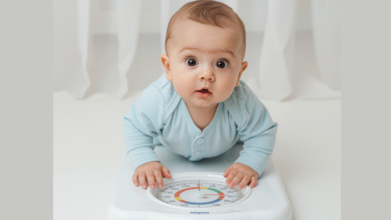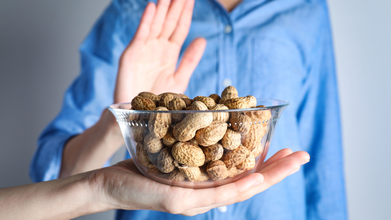- Health Conditions A-Z
- Health & Wellness
- Nutrition
- Fitness
- Health News
- Ayurveda
- Videos
- Medicine A-Z
- Parenting
- Web Stories
99th Percentile Baby: What It Means, Risks, And What Parents Should Know

Credits: Canva
While you cannot ever know everything about parenting, as there is always a new load of information. Right now, what is making rounds on TikTok is the 99th percentile baby trend. A Brisbane mom went viral after she shared her experience of giving birth to a baby in the 99th percentile for weight. Britanny Opetaia-Halls birthed her daughter who weighs 22 pounds, 9 ounces, which is about 5 pounds heavier than the average baby her age.
Dr Sermed Mezher, a digital health content creator, and a London based GP, shared: "Babies in the womb who measure in the 99th percentile for weight are referred to as macrosomic baby, meaning they are significantly larger than average for their gestational age. While most macrosomic babies are healthy, their larger size can increase the risk of certain complications during pregnancy and delivery."
What Does the 99th Percentile Mean for a Baby?
Babies in the 99th percentile for weight are larger than 99% of babies at the same gestational age. This may lead to birth complications such as shoulder dystocia—when the baby’s shoulders become stuck during delivery—or increase the likelihood of cesarean section. Mothers may also experience a higher risk of perineal tearing, postpartum hemorrhage, and greater pregnancy weight gain. Contributing factors include maternal diabetes, genetics, or excess weight gain during pregnancy.
This larger birth size is medically categorized under fetal macrosomia, which refers to babies in the top 10% of weight for gestational age—with the 99th percentile representing the most extreme cases.
What Causes a Baby to Be in the 99th Percentile?
There are certain reasons why a baby may fall into the 99th percentile for weight:
- You have a large fundal height (a measurement of fetal growth)
- Significant weight gain during pregnancy
- Gestational diabetes or pre-existing diabetes
- History of delivering large babies
- Prolonged pregnancy past due date
- Parental genetics (you were a large baby yourself)
How Is 99th Percentile Baby Diagnosed?
Your healthcare provider may recommend an ultrasound to estimate fetal weight and amniotic fluid volume. Ultrasound imaging can estimate weight within about 10%, but it isn’t precise. For example, if it estimates your baby weighs 9 pounds, the true weight could range between 8 to 10 pounds. While it can’t predict complications like shoulder dystocia, providers will assess all clinical factors to determine the safest delivery plan.
99th Percentile Baby: Possible Risks
According to a 2013 study published in the Maternal and Child Health Journal, babies born in the 99th percentile may face increased health risks later in life. Research shows they are 1.52 times more likely to become overweight or obese by age 7, and another study linked early childhood obesity to high birth weight.
These babies may also experience complications shortly after birth, including low blood sugar levels and a higher risk of developing metabolic syndrome—a cluster of conditions that raise the risk of heart disease, diabetes, and stroke.
Study Links Nighttime Phone Usage To Increased Risk Of Suicide In Children

(Credit-Canva)
Suicide attempts and overdose cases are rising among young people across the country. However, what is the cause behind this rise? In a new study, researchers found a concerning link between late-night screen time and these cases.
To find out the link, a research team from the Virginia Tech Carilion School of Medicine, led by Dr. Abhishek Reddy, a child and adolescent psychiatrist, is working to find better ways for families to protect their children before a crisis hits.
The researchers talked to teenagers between 12 and 17 years old who had been hospitalized after intentionally overdosing. Their main goal was to find out the when, how, and why of these dangerous events so that parents, doctors, and schools can step in much sooner.
They looked at three things together: the time of day the overdose happened, the teen's phone or screen use just before, and the type of medicine they took.
How Does Late Night Screen Time Affect Children?
American Academy of Child and Adolescent Psychiatry explains that on an average, children between the age of 8-18 in the US spend 7.5 hours watching or using screens, whether it is to entertain, teach or just to occupy themselves.
The study found very clear patterns. Most overdoses happened late at night, often while the teens were on their phones or computers, or right after. The pills used were a mix of both prescription drugs and simple over-the-counter medicines. This shows that it's the easy access to pills, not just strong ones, that can lead to a suicide attempt.
The researchers realized that late-night hours seem to be when young people feel the most emotional stress. When that feeling is mixed with instant access to social media and medicines readily available at home, the situation becomes very dangerous.
Experts warn that even common pills we think are safe, like pain relievers or allergy medicines, can be deadly in an overdose. Knowing the time and method helps create practical prevention plans that families can actually use. This information backs up national data showing that suspected suicide attempts by poisoning among teens jumped by over 30% recently.
Can Parents Prevent Overdosage In Children?
Even though the findings are serious, they point to things every family can do right away. The researchers suggest three main ways to help prevent overdoses:
- Limit screens late at night.
- Help teens develop good sleep habits.
- Lock up all medicines—both prescription and over-the-counter.
Simple changes can make a huge difference. Parents should set "digital curfews," perhaps by using apps to limit screen time or by making sure phones and tablets stay outside the bedroom after a set hour.
Help kids create a relaxing bedtime routine, like reading a book, to help them sleep better. It is just as important to lock or safely store all medicines, count how many pills are left, and immediately throw away any old or unused pills.
The researchers also stress that talking openly and honestly with your kids is key. Distress late at night, especially after arguments or seeing upsetting content online, can lead to impulsive actions. Checking in with your children about how they are feeling and what's happening in their online life can help defuse those risky moments.
Dr. Reddy said this research gives everyone specific things they can change—things like screen time and medicine storage. This is very valuable because we can move from simply knowing there is a crisis to taking concrete steps to stop it. The team hopes these ideas will lead to new programs focused on digital safety, safe medicine habits, and support for teens in crisis who need help late at night.
The main goal is to use this data to create simple, effective ways to prevent tragedies every day. Since suicide is a leading cause of death for children, and overdoses on easily found pills are common, helping parents focus on these safety measures could save young lives.
Parenting Habits That Creates Struggling Adults, According To Child Psychologist

Credits: Canva
Raising a child is not the easiest job. In fact, everyday feels like a new test. Somedays you would find yourself jumping to finish cleaning your child's toys even when you asked them to do. On other days, you would have a meltdown, but will have to manage to stop it.
But while you do all of these, there may be certain actions that may make your child into a struggling adult.
Child psychologist, and professor Daniel J Moran, of Touro University New York, told Newsweek, "Parents...are working overtime to make their children's lives smooth and happy. The intention is love, [but[ the outcome is often dependency."
This happens when parents remove discomfort from a child's life. The above example of the parent picking up child's toys is one such instance. If one has to apply science into it, children learn confidence by experiencing consequences and discovering that they can handle it. If parents get everything done for them, they will never know if they could handle a certain situation.
Moran says that true resilience comes from "hearing to stay present, feel the hard stuff and keep moving toward what matters."
Three Common Habits And Actions Of Parents That Could Take Away Their Child's Independence And Make Them A Struggling Adult
Fix Instead of Coach: This happens when parents jump in to solve every problem on their own. This teaches the kids that they do not have to work things on their own. Instead of fixing, parents must coach their kids, guide them into solving things.
Overpraising: While appreciating one's effort, especially when a child does something big for the first time is important. However, continuously praising your child on a day to day basis, without having to achieve something new or special could remove the learning value of effort and feedback. For every activity that a child does, praise is not the only feedback, it could also be critical in nature.
Overscheduling: Parents often feel the urge to teach their child everything, especially the things they wanted to learn as kids, but never got to. However, it leaves little room for boredom, which is dangerous, as Moran says that boredom is a place, "where creativity and self direction grow".
So, What Can Parents Do?
Moran says that the parents should let their kids "struggle safely". Parents can also model questions of acceptance of mistakes and ask reflective questions, such as "who do you want to be right now?"
"If we want confident, capable young adults, we have to let kids practice being uncomfortable,” Moran says. "Confidence doesn’t come from constant praise, but comes from persistence, problem-solving and purpose. A little discomfort today can build the psychological flexibility they’ll need tomorrow.”
Dr Samantha Whiten, clinical psychologist, owner of Best Life Behavioral Health tells Newsweek that overhelping often encourages overdependence. " Doing everything for your child when they can physically do things for themselves... trains them to depend on you for everything versus being proud and confident in what they can master on their own,” she says.
So Whiten recommends a steady approach that can build confidence. The first step is to demonstrate the task and let the child try it while you observe. Then leave the room, observe from afar, because you leaving the room would mean that you are confident in your child.
Fewer Children Are Now Allergic To Peanuts, Study Reveals The Key To Lesser Allergies In Kids

(Credit-Canva)
Allergies are common, and anyone can develop them at any age. An allergy is an immune response that occurs when the body mistakes a harmless substance for a threat.. This then causes your body to overreact, leading to symptoms that range from mild to life threatening. One of the most common allergens is peanuts. However, recent studies have shown that there is a way we can lower the risk of developing this allergy.
A new study has found that food allergies in young children have fallen sharply since 2017, when the guidelines for introducing common allergens into the child’s diet were changed.
For many years, experts advised parents to avoid giving common allergens to their babies because allergy rates were climbing. However, a major study in 2015 discovered that feeding peanuts to infants could slash their risk of developing a peanut allergy by over 80%. Based on this finding, the National Institute of Allergy and Infectious Diseases issued official guidelines in 2017 recommending this early-introduction approach.
How Much Did Peanut Allergy Cases Go Down?
The study, published in the journal Pediatrics, analyzed food allergy rates in children under the age of three before and after the 2017 guidelines were issued. The results showed a significant decline:
- Overall food allergies dropped to 0.93% between 2017 and 2020, down from 1.46% between 2012 and 2015.
- This represents a 36% reduction in all food allergies.
- The decline was mainly driven by a huge 43% drop in peanut allergies.
- The study noted that eggs have now taken over peanuts as the most common food allergen in young children.
Can People Outgrow Allergies?
While the study didn't directly track what infants were fed, the data is highly encouraging because the drop in allergies happened right after the new guidelines were put into effect.
While the results are highly encouraging, the study noted that many doctors and parents still haven't fully adopted the new advice. Surveys show that full compliance remains low among both pediatricians and caregivers.
The study also found shifts in the racial and ethnic breakdown of children diagnosed with food allergies. Compared to the pre-guidelines period, there were fewer food-allergic children who were Black, Asian or Pacific Islander, and Hispanic in the post-guidelines period, with an increased proportion of White children. The researchers noted that these changes might reflect differences in how easily different groups can access healthcare and information about the new feeding practices.
Experts see this as a major public health success. Experts see this as a major public health success, noting that the data provide real-world evidence of how a simple public health recommendation can improve children’s health. This is particularly important for peanut allergies, which 80% of people never outgrow and can be life-threatening.
While the reasons for food allergies are still not completely understood, some scientists believe factors like higher rates of C-section births, early use of antibiotics, and increasingly sanitized environments may still play a role. However, the data suggests that early introduction is a powerful tool to protect children.
© 2024 Bennett, Coleman & Company Limited

